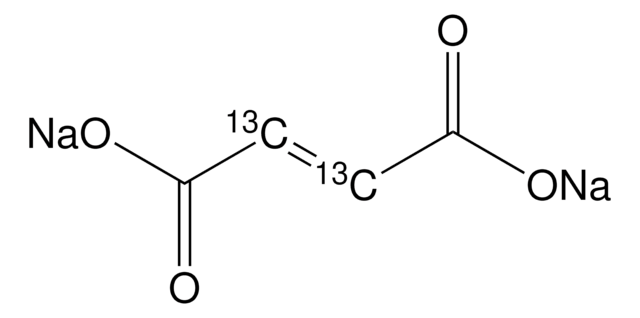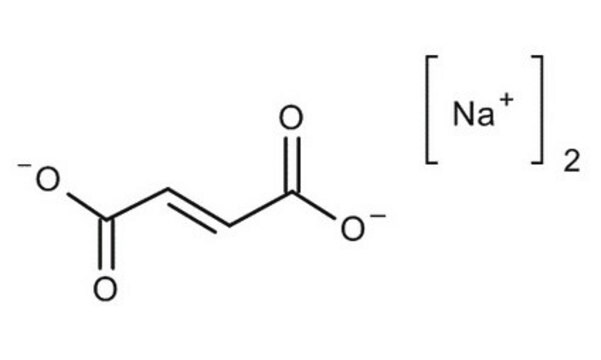F1506
Sodium fumarate dibasic
≥99%
Sinonimo/i:
Disodium fumarate, Fumaric acid disodium salt
About This Item
Prodotti consigliati
Livello qualitativo
Saggio
≥99%
Stringa SMILE
[Na+].[Na+].[O-]C(=O)\C=C\C([O-])=O
InChI
1S/C4H4O4.2Na/c5-3(6)1-2-4(7)8;;/h1-2H,(H,5,6)(H,7,8);;/q;2*+1/p-2/b2-1+;;
MSJMDZAOKORVFC-SEPHDYHBSA-L
Cerchi prodotti simili? Visita Guida al confronto tra prodotti
Applicazioni
- Enhancement of drug absorption: Sodium fumarate dibasic is utilized to improve the dissolution behavior and oral absorption of drugs with pH-dependent solubility, enhancing bioavailability and therapeutic efficacy in pharmaceutical applications (Salehi et al., 2021).
- Development of novel drug carriers: The compound is used in the synthesis and characterization of novel injectable drug carriers, aiming to enhance the delivery and efficacy of therapeutic agents in medical treatment strategies (Guo et al., 2005).
Codice della classe di stoccaggio
11 - Combustible Solids
Classe di pericolosità dell'acqua (WGK)
WGK 3
Punto d’infiammabilità (°F)
Not applicable
Punto d’infiammabilità (°C)
Not applicable
Dispositivi di protezione individuale
dust mask type N95 (US), Eyeshields, Gloves
Certificati d'analisi (COA)
Cerca il Certificati d'analisi (COA) digitando il numero di lotto/batch corrispondente. I numeri di lotto o di batch sono stampati sull'etichetta dei prodotti dopo la parola ‘Lotto’ o ‘Batch’.
Possiedi già questo prodotto?
I documenti relativi ai prodotti acquistati recentemente sono disponibili nell’Archivio dei documenti.
I clienti hanno visto anche
Articoli
Learn about the four membrane-bound protein complexes that make up the electron transport chain metabolic pathway supplying energy as ATP for cellular respiration.
Information on fatty acid synthesis and metabolism in cancer cells. Learn how proliferatively active cells require fatty acids for functions such as membrane generation, protein modification, and bioenergetic requirements. These fatty acids are derived either from dietary sources or are synthesized by the cell.
Il team dei nostri ricercatori vanta grande esperienza in tutte le aree della ricerca quali Life Science, scienza dei materiali, sintesi chimica, cromatografia, discipline analitiche, ecc..
Contatta l'Assistenza Tecnica.









